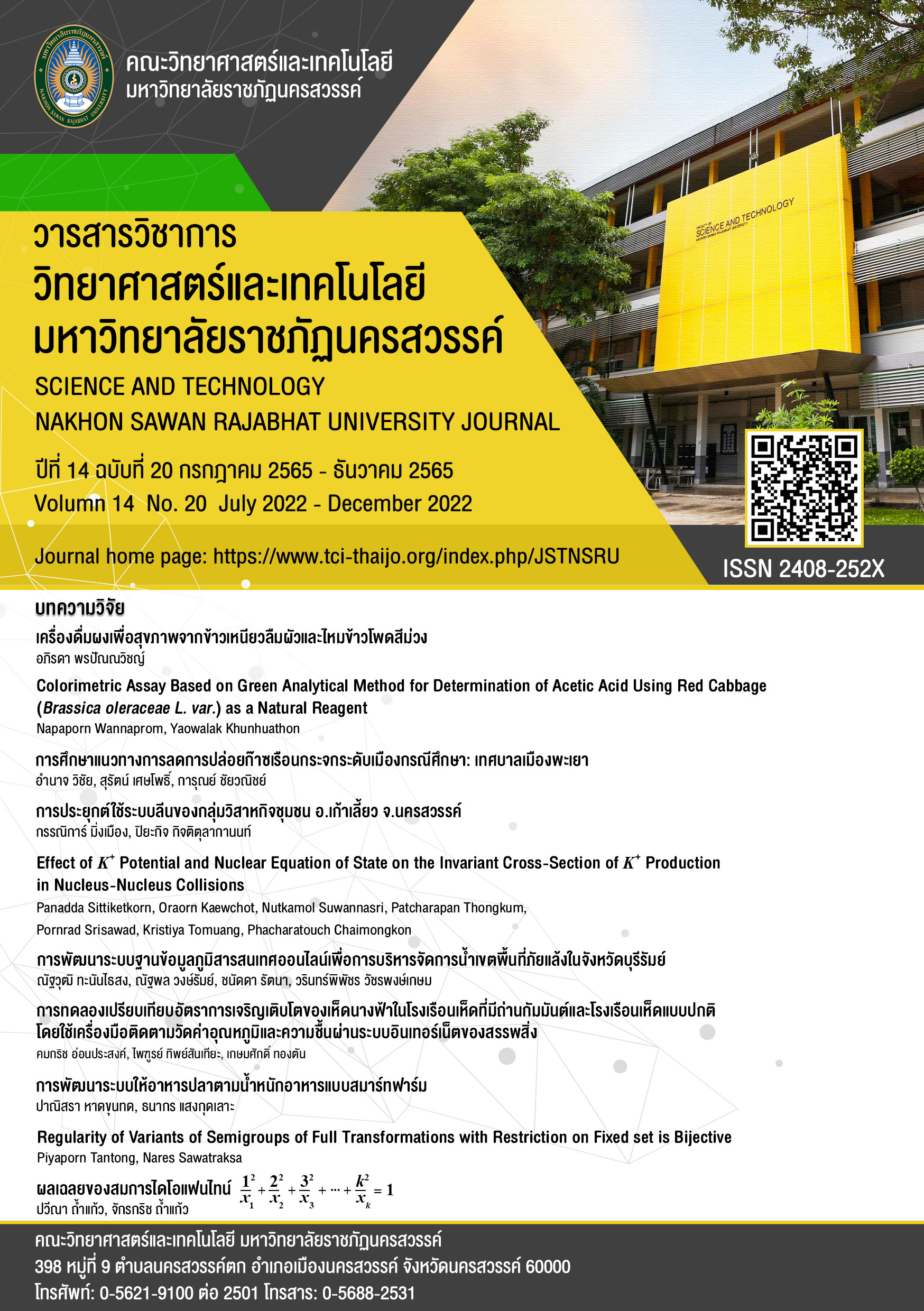Colorimetric Assay Based on Green Analytical Method for Determination of Acetic Acid Using Red Cabbage (Brassica oleraceae L. var.) as a Natural Reagent
Main Article Content
Abstract
A green portable micro-scale colorimetric technique was developed for acetic acid determination. This system is controlled via an application on mobile phone. Furthermore, red cabbage (Brassica oleraceae L. var.) extracts were used as an alternative natural reagent for the quantification of acetic acid. The purple color of cyanidin contained in the red cabbage extracts reacted with acetic acid to produce a magenta color substance and showed maximum absorption wavelength at 525 nm. The various parameters for optimum condition were investigated. Under the suitable condition, a linear calibration graph in the range of 1.00-5.00 %w/v acetic acid (y = 0.063x + 0.142, R2 = 0.9777) was obtained with LOD and LOQ of 0.03 and 0.20 %w/v, respectively. The tests were produced 6 times (n = 6) to ensure the precision of the proposed technique, and showed 3.4, 2.2, and 1.0 %RSD for 1.00, 3.00, and 5.00 %w/v of acetic acid, respectively. The proposed method was successfully applied to determine acetic acid in vinegar samples. The results agreed well with the standard method with a non-significant difference at 95% confidence interval. The proposed method presented many advantages such as using a cost-effective and environmental friendly analysis system, less toxic and producing less waste.
Article Details

This work is licensed under a Creative Commons Attribution-NonCommercial-NoDerivatives 4.0 International License.
References
Ahmadiani, N., Robbins, R. J., Collins, T. M., & Monica Giusti, M. (2016). Molar absorptivity () and spectral characteristics of cyanidin-based anthocyanins from red cabbage. Food Chemistry, 197, 900–906. https://doi.org/10.1016/j.foodchem.2015.11.032
Anastas, P. T. (1999). Green chemistry and the role of analytical methodology development. Critical Reviews in Analytical Chemistry, 29(3), 167–175. https://doi.org/10.1080/10408349891199356
Chigurupati, N., Saiki, L., Gayser, C., & Dash, A. K. (2002). Evaluation of red cabbage dye as a potential natural color for pharmaceutical use. International Journal of Pharmaceutics, 241, 293–299.
https://doi.org/10.1016/S0378-5173(02)00246-6
Galán-Vidal, C. A., Castańeda-Ovando, A. Páez-Hernández, M. E., & Contreras-Lopez, E. (2014). Determination of nitrites in commercial sausages by anthocyanins degradation. Experimental design and optimization. Journal of the Mexican Chemical Society, 58(2), 180–184.
González-Rodríguez, J., Pérez-Juan, P., & Luque de Castro, M. D. (2001). Two-parameter determination in vinegar by a flow injection–pervaporation system. Analyst, 126, 1177–1181. https://doi.org/10.1039/b102185k
Khaodee, W., Aeungmaitrepirom, W., & Tuntulani, T. (2014). Effectively simultaneous naked-eye detection of Cu(II), Pb(II), Al(III) and Fe(III) using cyanidin extracted from red cabbage as chelating agent. Spectrochimica Acta Part A: Molecular and Biomolecular Spectroscopy, 126, 98–104. https://doi.org/10.1016/j.saa.2014.01.125
Lin, S., Zhang, J., Gao, Y., Zhang, X., Song, S., & Long, Z. (2014). Rapid and sensitive gas chromatography-triple quadrupole mass spectrometry method for the determination of organic acids in tobacco leaves. Analytical Methods, 6, 5227–5235. https://doi.org/10.1039/c4ay00688g
Manz, A., Graber, N., & Widmer, H. M. (1990). Miniaturized total chemical analysis systems: a novel concept for chemical sensing. Sensors and Actuators, B1, 244–248. https://doi.org/10.1016/0925-4005(90)80209-I
Ministry of Public Health. (2000). Notification of the Ministry of public Health (No. 204): vinegar., Bangkok: Prachachon.
Pinyou, P., Hartwell, S.K., Jakmunee, J., Lapanantnoppakhun, S., & Grudpan, K. (2010). Flow injection determination of iron ions with green tea extracts as a natural chromogenic reagent. Analytical Sciences, 26, 619–623. https://doi.org/10.2116/analsci.26.619
Prietto, L., Mirapalhete, T. C., Pinto, V. Z., Hoffmann, J. F., Vanier, N. L., Lim, L-T., Guerra Dias, A. R., & da R. Zavareze, E. (2017). pH-sensitive films containing anthocyanins extracted from black bean seed coat and red cabbage. LWT-Food Science and Technology, 80, 492–500. https://doi.org/10.1016/j.lwt.2017.03.006
Settheeworrarit, T., Hartwell, S. K., Lapanatnoppakun, S., Jakmunee, J., Christan, G. D., & Grudpan, K. (2005). Exploiting guava leaf extract as an alternative natural reagent for flow injection determination of iron. Talanta, 68, 262–267. https://doi.org/10.1016/j.talanta.2005.07.039
Silva-Pereira, M. C., Teixeira, J. A., Pereira-J únior, V. A., & Stefani, R. (2015). Chitosan/corn starch blend films with extract from Brassica oleraceae (red cabbage) as a visual indicator of fish deterioration. LWT-Food Science and Technology, 61, 258–262. http://doi.org/10.1016/j.lwt.2014.11.041
Siriangkhawut, W., Khanhuathon, Y., Chantiratikul, P., Ponhong, K. & Grudpan, K. (2016). A green sequential injection spectrophotometric approach using natural reagent extracts from heartwood of Ceasalpinia sappan Linn. for determination of aluminium. Analytical Sciences, 32, 329–336. https://doi.org/10.2116/analsci.32.329
Supharoek, S., Ponhong, K., Siriangkhawut, W., & Grudpan, K. (2018). Employing natural reagents from turmeric and lime for acetic acid determination in vinegar sample. Journal of Food and Drug Analysis, 26(2), 583–590. https://doi: 10.1016/j.jfda.2017.06.007
Tavares Araújo, C.S., Lira de Carvalho, J., Ribeiro Mota, D., de Araújo, C. L., & Coelho, N. M. M. (2005). Determination of sulphite and acetic acid in foods by gas permeation flow injection analysis. Food Chemistry, 92, 765– 770. hhttps://doi.org/10.1016/j.jfda.2017.06.007
Ueda, M., Lapanantnoppakhun, S., Wongwilai, W., Teshima, N., Sakai, T., & Grudpan, K. (2010). Exploiting a simple water extract of a flower as a natural reagent for acidity assay using a lab-on-chip. Journal of Flow Injection Analysis, 27(1), 57–60.
USHIO Inc., (2017, June 12). PiCOEXPLORERTM PAS-110 photo bsorbance sensor. https://www.ushio.com/product/picoexplorer-pas110/
Wittmann, Gy., Van Langenhove, H., & Dewulf, J. (2000). Determination of acetic acid in aqueous samples, by water-phase derivatisation, solid-phase microextraction and gas chromatography. Journal of Chromatography A, 874, 225–234. https://doi.org/10.1016/s0021-9673(00)00114-x
Wongwilaia, W., Lapanantnoppakhuna, S., Grudpan, S., & Grudpana, K. (2010). Webcam camera as a detector for a simple lab-on-chip time based approach. Talanta, 81, 1137–1141. https://doi.org/10.1016/j.talanta.2010.01.058
Xie, W.Q., & Chai, X. S. (2017). Determination of total acid content in vinegars by reaction- based headspace gas chromatography. Food Analytical Methods, 10(2), 419–423. https://doi.org/10.1007/s12161-016-0595-2


